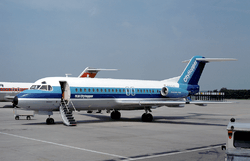NLM CityHopper Flight 431
|
PH-CHI, the aircraft involved in the accident, is seen here at Euroairport. (1979) | |
| Accident summary | |
|---|---|
| Date | 6 October 1981 |
| Summary | Structural failure in severe turbulence[1]:183 |
| Site |
near Moerdijk 51°42′N 4°31′E / 51.700°N 4.517°ECoordinates: 51°42′N 4°31′E / 51.700°N 4.517°E |
| Passengers | 13 |
| Crew | 4 |
| Fatalities | 17 (all) |
| Survivors | 0 |
| Aircraft type | Fokker F-28-4000 |
| Aircraft name | Eindhoven |
| Operator | NLM CityHopper |
| Registration | PH-CHI |
| Flight origin | Rotterdam Airport |
| Stopover | Eindhoven Airport |
| Destination | Hamburg Airport |
NLM CityHopper Flight 431 refers to a Fokker F-28-4000, registration PH-CHI, that was due to operate an international scheduled Rotterdam–Eindhoven–Hamburg passenger service. On 6 October 1981, the aircraft encountered severe weather on the first leg, minutes after taking off from Rotterdam Airport, and crashed 15 miles (24 km) south-southeast of Rotterdam. All 17 occupants of the aircraft – 13 passengers and crew of 4 – perished in the accident.[1]:183[2]
Aircraft
The aircraft involved in the accident was a Fokker F28-4000, registration PH-CHI, that was built in 1979 with c/n 1141. At the time of the accident the airframe had accumulated 4,485 flight hours and 5,997 cycles.[2]
Description of the accident
During the weather briefing 44 minutes before takeoff, the crew was apprised to an area of strong thunderstorms with 3/8 (37.5%) sky coverage of cumulonimbus at a base of 1,200 feet (370 m), south-southwest winds 15 to 25 knots (28 to 46 km/h; 17 to 29 mph) strong, and 5 kilometres (3.1 mi) visibility at Rotterdam Airport.[2] The aircraft took off at 5:04 p.m. CET (UTC +1) from Rotterdam Airport.[2] The crew noted heavy rain in thunderstorms on the airplane's weather avoidance radar at 5:09 p.m., receiving clearance to avoid the area.[2] At 5:12 p.m. the aircraft entered a tornado while flying through clouds.[2] The weather system the aircraft entered into was apparently the same "tornado-like" system that Zeeland locals described as being responsible for considerable property damage.[3] Meteorologically, these vortices are indeed tornadoes, and the disintegrating airliner was seen exiting cloud cover. A police officer first photographed the tornado, then smoke from the burning plane a few minutes later. An investigation concluded that a sharp increase in altitude registered on the altimeter was not a change in altitude, rather a pressure drop associated with the tornado.[4][5]
Stresses experienced by the airframe owing to severe turbulence resulted in loads of +6.8 g and −3.2 g causing the starboard wing to detach.[2][6] The aircraft spun down into the ground from 3,000 ft (910 m), crashing some 400 m (1,300 ft) from a Shell chemical plant on the southeastern outskirts of Moerdijk.[3] All 17 occupants of the aircraft perished in the accident.[2]
See also
References
- 1 2
- Learmount, David (23 January 1982). "Commercial flight safety: 1981 reviewed". Flight International. 121 (3794): 183. ISSN 0015-3710. Archived 22 January 2015 at the Wayback Machine.
- "Commercial flight safety: 1981 reviewed". Flight International: 184. Archived 22 January 2015 at the Wayback Machine.
- "Commercial flight safety: 1981 reviewed". Flight International: 185. Archived 22 January 2015 at the Wayback Machine.
- "Commercial flight safety: 1981 reviewed". Flight International: 186. Archived 22 January 2015 at the Wayback Machine.
- 1 2 3 4 5 6 7 8 Accident description at the Aviation Safety Network. Retrieved on 14 November 2011.
- 1 2 "F.28 crashes in bad weather". Flight International: 1127. 17 October 1981. Archived from the original on 29 July 2013.
- ↑ Grazulis, Thomas P. (2001). The Tornado: Nature's Ultimate Windstorm. Norman, OK: University of Oklahoma Press. pp. 260–1. ISBN 0-8061-3258-2.
- ↑ Roach, W.T.; J. Findlater (February 1983). "An Aircraft Encounter with a Tornado". Meteorological Magazine. London: Meteorological Office. 112 (1327): 29–49.
- ↑ "F.28 wing loss followed severe turbulence". Flight International: 1124. 17 October 1981. Archived from the original on 29 July 2013.
